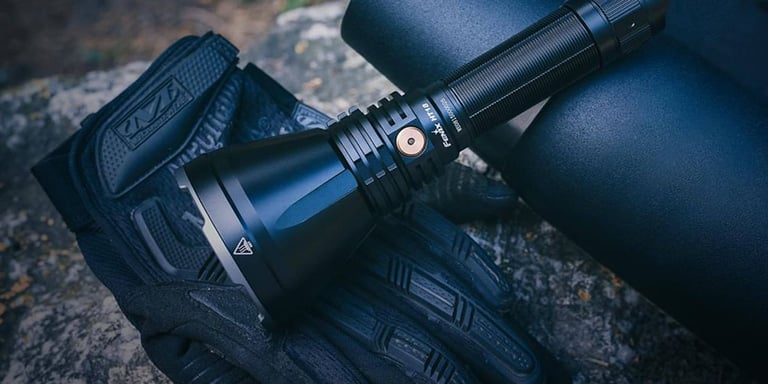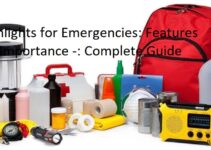Are you confused by tactical flashlights? Look no further! This article is your complete guide to the features and benefits of tactical flashlights.
Read on to equip yourself with the knowledge to make informed decisions when buying a reliable and efficient flashlight. With this guide, you can select the right tool that fits your needs.
Flashlights can be incredibly useful tools for a variety of activities, from general uses around the house to tactical use for professionals. In this comprehensive guide, we will explore the different features and benefits that are associated with tactical flashlights.
We’ll look at how you can evaluate different models and gain a better understanding of their features such as output, run-time, beam type, battery type and more. By the end of this guide, you’ll be equipped with the information needed to make an informed decision when choosing the right flashlight for your needs.

Explanation of Tactical Flashlights
Tactical flashlights are an essential tool for many law enforcement, military and survival applications. They provide superior lighting capability in challenging conditions, often exceeding the performance of standard torches by including extra features such as a beam that can more easily penetrate thick smoke, hazardous materials and even thick foliage. Whatever your reasons for needing tactical flashlights, this guide explains the most important features of these powerful torches and helps you to get the best out of them for your needs.
Tactical flashlights can typically come with an adjustable focus to vary from a tight spot with a long-distance reach, to wide beams for close-up illumination. High power LED bulbs that generate ultra-bright white light are usually used, which is far better than the yellow glow emitted by traditional incandescent bulbs found in regular flashlights. The intensity or brightness of tactical flashlight beams is measured in lumens; as such many feature multiple modes, allowing you to adjust brightness levels depending on specific applications. In some cases lumens are adjustable through a single-button control system, while other devices offer additional programming capabilities which enable tailored settings suitable for particular tasks or vision impairments.
Batteries may also be a crucial factor when selecting your device; due to their advanced lighting technology; some models may require higher output cells than those needed by standard torches. However many recent tactical devices use high efficiency standard batteries plus added components like circuit regulators and intelligent electronics -allowing longer burn times without significantly affecting weight or size. Additionally several shapes and sizes are available such as pistol grips and slender batons; each favored according to individual needs along with ease-of-use dictated through personal preference or experience level. Depending on type you choose most will have additional features too -such as strobe flashes used during emergency situations or self defense along with waterproof casing. Finally don’t overlook purpose built clever accessories like stands tripods or filters which can improve effectiveness & safety whilst developing enhanced vision capabilities in certain operational scenarios.
Importance of Understanding Tactical Flashlights

The use of tactical flashlights offers numerous benefits, such as improved visibility in low-light conditions, the ability to make use of natural light in different environments, and the encryption of blinding light that is commonly used by law enforcement officers. Even more importantly, when used strategically, tactical flashlights can provide a psychological advantage over an assailant.
Increasingly popular among military personnel and outdoor enthusiasts alike, tactical flashlights offer superior strength and durability compared to traditional lights. They are usually made from solid aluminum alloy or other higher-strength metals for maximum durability and typically have aircraft-grade anodized coating for protection against wear and tear. Tactical flashlights also tend to be waterproof so they can be consistently reliable regardless of the environment.
There are a variety of features which can take a person’s understanding of tactical flashlights to the next level. Some lights offer variable outputs adjusting from lower output levels ideal for navigation purposes up through higher levels appropriate for blinding distractions or signals. A strobe feature is also offered on some models as an additional nonlethal deterrent option which flashes rapidly and causes temporary visual confusion when shone directly into someone’s eyes. Additionally, tactical flashlights also come equipped with robust push button switches that allow quick activation — often requiring fewer than two presses to toggle between various modes — making it easier to get light in any situation quickly.
Overview of the Complete Guide
This guide serves as an introduction and comprehensive guide to understanding tactical flashlights. In this guide, we will cover the following topics: what a tactical flashlight is; its features and benefits; and how to choose the best one for your needs.
We’ll also provide some tips on how to use tactical flashlights safely. Additionally, we will provide a buyer’s guide with valuable tips and tricks on choosing the right flashlight for you.
Finally, we’ll conclude with some suggested reviews of currently available tactical flashlights so that you can make an informed decision in selecting the right one for your needs.
Features of Tactical Flashlights

Tactical flashlights are one of the best-featured and multi-functional flashlights on the market. While their primary use is to provide illumination in low light situations, they come with a variety of features that can make them indispensable for many different scenarios.
Some of the features found on tactical flashlights include:
- High Lumen Output: Most tactical flashlights are designed to produce a high level of illumination, usually two or more times higher than that of an ordinary flashlight. This high level of brightness is achieved through careful choice of bulb and optics.
- Adjustable Focus: Tactical flashlights often feature adjustable focus for greater accuracy and precision at long distances. The adjustable focus allows you to move the beam from a wide area to a more pinpointed shape, depending on your needs.
- Strobe Function: A strobe function allows you to temporarily blind someone in an emergency situation while also alerting nearby people or authorities. Many tactical lights have both controllable strobe speeds and intensity levels so you can adjust them as needed.
- Low Battery Indicators: Many tactical flashlights come with built in low battery indicators that alert you by blinking several times when it’s time to recharge your device. This feature saves time by keeping you updated on your battery’s levels so you can plan ahead for potential power outages or emergency situations.
These are just a few great features that are inherent to most tactical lights, making them indispensable tools for outdoor activities, emergency planning, and general protection against darkness.
Durability and Build Quality
The durability and build quality of your tactical flashlight are key factors to consider when making a purchase. The number one enemy of any flashlight will be water, dirt, and dust, so look for products with robust O-rings that create a waterproof seal.
It is also important to check the material of the casing and other components. High-grade aluminum is lightweight but strong. While it won’t be as durable as stainless steel, it will do its job well against bumps and scratches. For even more stability, check for features like anti-roll designs or grip texture for non-slip handling in wet conditions.
When selecting a lens material, look for scratch resistant plastics like polycarbonate.
Brightness and Lumens
The brightness of a tactical flashlight is measured in lumens. This is the amount of light which is emitted when a bulb or LED chips are illuminated. The higher the number of lumens, the brighter a flashlight will be. Generally speaking, the brighter a tactical light is, the better it will perform in adverse conditions such as low visibility or in defensive tactics.
For example, an 800-lumen beam will provide intense illumination while using low power consumption and also allowing long runtimes on a single battery charge. A 500-lumen flashlight can still illuminate enough objects or provide floodlighting if necessary and this level of brightness often offers sufficient illumination for most tasks and applications without over straining batteries or compromising operational times.
Therefore it should be remembered that lumens above 1000 are not always needed for most everyday tactical applications, with lumen power between 500 -1000 being more than sufficient depending on personal preference.
Battery Life
Battery life is one of the most important factors to consider when looking for a tactical flashlight. The longer the battery life, the longer you’ll be able to use your flashlight and enjoy its features. Rechargeable flashlights are often recommended due to their superior performance in terms of battery life.
The battery life of a tactical flashlight can vary depending on the type and size of the battery as well as how you use it. The type of light output (high, medium, low) and length of time that it is used for will all play a role in how long your flashlight’s battery will last.
Most tactical flashlights provide two main types of Battery Life measurements, runtime and beam intensity – Runtime refers to how long a flashlight can work on a single charge while beam intensity rates what level brightness light output you get over time or distance. Generally speaking, larger batteries such as 18650 lithium-ion cells or extended alkaline AA batteries will produce better results when it comes to both runtime and beam intensity but can also add bulk/weight to the overall design Profile of your Tactical Flashlight while smaller CR123A Lithium Batteries or AAA Batteries provide more compact design solutions with a slightly lower high output & Beam Intensity capability which is often acceptable in many situations regardless.
Size and Weight
The size of the flashlight and its weight should always be considered when choosing a tactical flashlight. It is important to find one that can fit comfortably in your hand while also giving you enough control to operate it accurately. Additionally, be sure to consider where you will be carrying it on your body, or if you plan to use a holster or pouch for added convenience.
Portability is also an important factor. If you plan on using your tactical flashlight for everyday carry or during strenuous activities like camping and hiking, look for one with a smaller size and lighter weight construction. This will help ensure it doesn’t weigh you down or become an obstacle when making quick movements.
Water Resistance
One of the most important features to consider when purchasing a tactical flashlight is water resistance. Flashlights with a water-resistant rating indicate that the unit can withstand exposure to moisture and is especially important for use in inclement weather or outdoors. The most common ratings are IPX4 and IPX8.
IPX4 has been tested for up to 8 minutes of exposure to water sprayed from all angles, whereas IPX8 has been tested for immersions up to 1 meter and longer underwater. In order for an LED flashlight to be advertised as waterproof, it must meet certain standards set forth in the IEC 60529 code, a set of standards used around the world regarding ratings such as dustproof, corrosion resistance and water resistance.
Another level of water-resistance you may hear advertised is dustproof rating, which indicates how well a flashlight will resist dust getting into its internal parts. Dustproof ratings usually range between 5-7 on an international scale; 5 is equivalent to full resistance against dust while 7 means total prevention against all dust entering internal components – also known as fully sealed against dust particles.
Conclusion

Flashlights come in all shapes, sizes, and features. After reading this guide, you should have an understanding of the available features, pros and cons for each type of flashlight and what to look for when you are shopping for a tactical flashlight. Knowing the beam characteristics, lumens levels and beam distances is especially beneficial when determining how powerful a light needs to be and how far it will reach.
Consider your specific lighting requirements before making a purchase and make sure it fits securely on your person while you are in dark or dangerous areas. It is also important to inspect whether any certifications have been achieved when you choose a model (purchasing batteries is often part of that process as well).
The bottom line: no matter which tactical flashlight you decide on – whether it’s an LED flashlight, Xenon flashlight or something else entirely – having one will give you greater confidence when regular lighting isn’t available. You can have greater control over the conditions around due to the dependability of your tactical light!
FAQs
What are the benefits of a tactical flashlight?
Tactical flashlights are brighter and more durable than regular flashlights. They also have additional features such as strobe mode and crenelated bezel for self-defense.
What should I look for in a tactical flashlight?
Brightness (measured in lumens), durability, battery life, tactical features such as strobe mode, size and weight, water resistance, and shock resistance.
What are the features of a flashlight?
On/off switch, bulb or LED, battery compartment, reflector or lens, housing or casing, and optional features such as adjustable focus, strobe mode, etc.
What is the difference between a flashlight and a tactical flashlight?
Tactical flashlights are designed to be brighter and more durable than regular flashlights. They often have additional features such as strobe mode and a crenelated bezel for self-defense.
Why do tactical flashlights have strobe?
Strobe mode can disorient an attacker and give the user an advantage in a self-defense situation.
Can you carry a tactical flashlight?
Yes, you can carry a tactical flashlight in most places. However, it’s important to check local laws and regulations.
How powerful of a flashlight do I need?
The amount of power you need depends on your intended use. For everyday carry, a flashlight with 200-300 lumens should be sufficient. For outdoor or tactical use, a flashlight with 1000 lumens or more may be necessary.
Why is a flashlight good for self-defense?
A bright flashlight can temporarily blind an attacker, giving the user time to escape or defend themselves. A tactical flashlight with a crenelated bezel can also be used as a striking tool.
What tactical flashlight can start a fire?
Some tactical flashlights have a built-in firestarter. These flashlights typically have a serrated bezel or a ferrocerium rod that can be used to create sparks to start a fire.
What is a lumens tactical flashlight?
Lumens is a unit of measurement for the brightness of a flashlight. A tactical flashlight with a high number of lumens will be brighter than one with a lower number of lumens.
See More
- Best 18650 for flashlight 2023
- Best aa flashlight 2023
- Best camping flashlight 2023
- Best edc flashlight 2023
- Best flashlight for emergencies 2023


